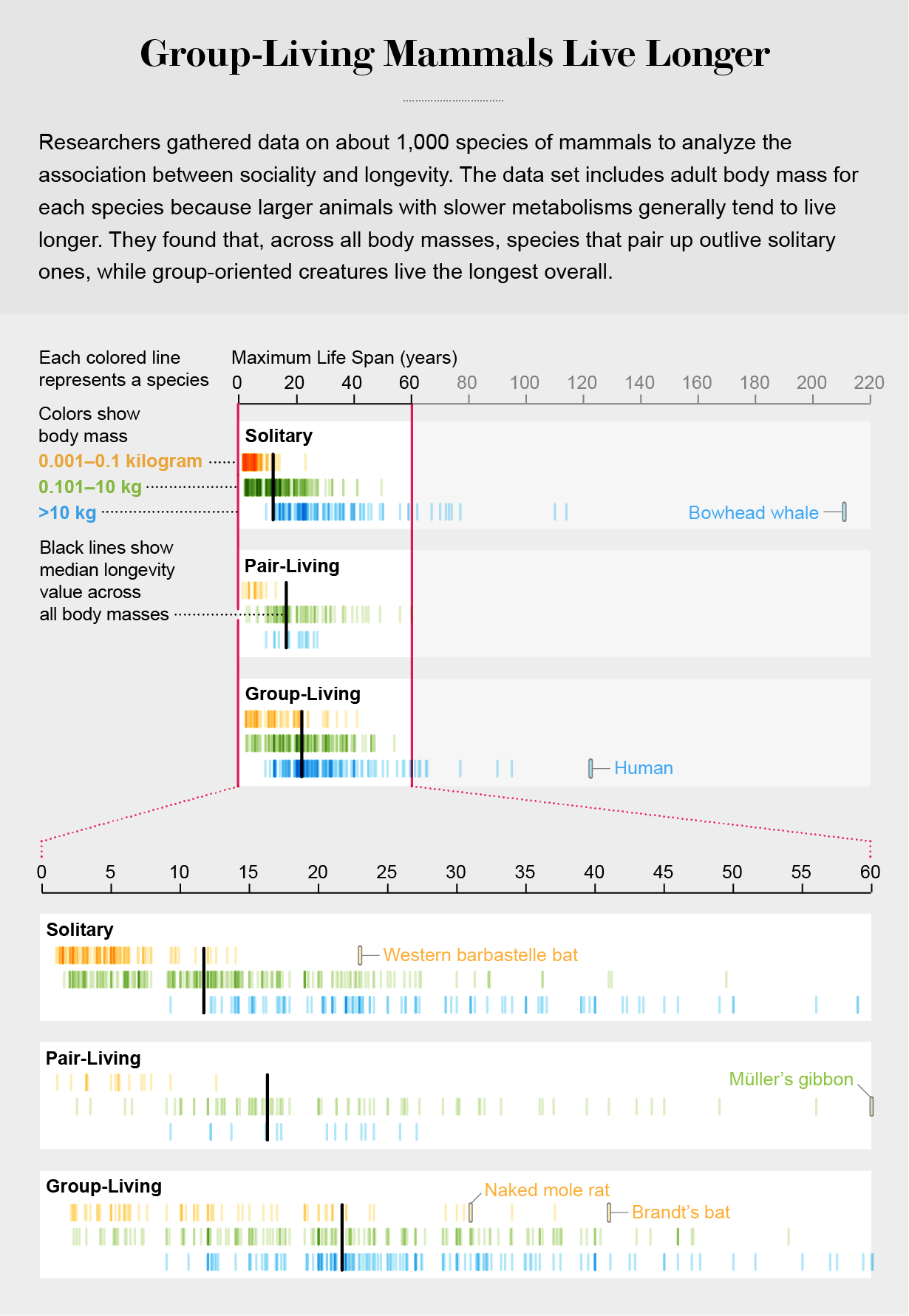Mammals only have one life to live, but the length of that life varies greatly. While some shrews shuffle off this mortal coil in less than 14 months, bowhead whales can swim in Arctic waters for more than two centuries. And longevity is not all about size. For example, 250-pound brown bears (with a maximum life span of 40 years) are outlived, on average, by Brandt’s bats (with maximum of 41 years), a species small enough to perch inside the palm of a human hand.
Instead one of the most important factors impacting a mammal’s life span may be the company it keeps. A team of researchers recently analyzed the longevities and lifestyles of nearly 1,000 species of mammals, ranging from aardvarks to zebras. In a study published on Tuesday in Nature Communications, the team discovered that group-living mammals such as ring-tailed lemurs and elephants generally outlive solitary species such as tigers and chipmunks.
The project started when evolutionary biologist Xuming Zhou and his colleagues at the Chinese Academy of Sciences’ Institute of Zoology were examining aging in exceptionally long-lived mammals. The longevity of one particular species jumped out: the naked mole rat. These bucktoothed, wrinkly rodents can live for up to 31 years, a life span longer than that of several much larger mammals such as wolves and bighorn sheep.
Beyond just longevity, these hairless rodents also exhibit one of the most complex social structures known in mammals: a queen mole rat and castes of nonbreeding workers cooperatively live together in subterranean burrows. Several other social mammals, especially primates, also have a prolonged life span—and that connection can even extend to individual animals within a single species. For example, previous studies discovered that female chacma baboons with strong social bonds outlived their less social counterparts.
To determine if a link between sociability and longevity existed on a broader scale, Zhou and his team combed the scientific literature for the maximum life spans of 974 different mammalian species. They sorted this menagerie into groups based on three mammalian modes of life: mammals that lived alone, in pairs or in larger groups.

They found that when it comes to living longer, being part of the herd is better than being a lone wolf. Though species that lived in pairs such as Müller’s gibbons tended to live longer than loner species such as aardvarks, group-living species such as elephants generally lived the longest. This trend also held true when the researchers examined similarly sized mammals. For example, the northern short-tailed shrew weighs roughly the same amount as the greater horseshoe bat. The solitary shrew only survives for around two years, however, whereas the group-living bat can flutter for more than 30 years.
According to Zhou, there were a few exceptions to this trend. “Sumatran orangutans are generally solitary but can live up to 60 years [while] some rodents that live in a group, such as Bennett’s chinchilla rats and Norway rats, only live two to four years,” he says. The largest outlier is the bowhead whale. Though these leviathans are often loners, they can live for more than 200 years, making their longevity more than double that of more social species such as sperm and humpback whales.
But the majority of mammals surveyed in the new study supported the connection, leading the researchers to conclude that social organization and longevity likely evolved together in mammals.
According to George Washington University biological anthropologist Brenda Bradley, who studies population genetics in primates and was not involved in the new study, examining such a wide swath of mammalian diversity helps crystalize the relationship between sociability and longevity. “It’s often difficult to disentangle these variables, but the beauty of a huge comparative analysis like this new study is that you can start to tease these things apart,” she says.
The traits may be evolutionary linked for several reasons. The researchers speculate that group-living mammals tend to be less susceptible to predation or starvation than mammals that are on their own. Additionally, instead of rushing to reproductive age and pumping out droves of offspring, social animals tend to have a slower pace of life. They produce fewer young, investing more time and energy to nurture social bonds that can yield survival benefits in the future. Together, these benefits likely outweigh the drawbacks of living in large groups, such as competition over food and mates. So “strong and stable social bonds formed among group members have the power to enhance longevity,” Zhou says.
To pinpoint specific genes that may contribute to the link between sociability and a longer life span, the team dissected nearly 300 brain samples from 94 different mammals. The brains came from species with maximum ages ranging from a tad more than three years (the Chinese mole shrew) to more than 122 years (humans). After dissection, the brain samples were frozen with liquid nitrogen and analyzed in microscopic detail.
The team identified 31 genetic traits associated with both social organization and longevity. Many of these traits boosted immune responses or regulated hormones. In large groups, strong immunity is essential because parasites and pathogens can quickly spread among related individuals living in tight quarters. And hormones come in handy in a range of social situations, helping mammals groom, mate and even parent.
According to Daniel Blumstein, a conservation biologist at the University of California, Los Angeles, who studies longevity in yellow-bellied marmots and was not involved in the new study, connecting social genes to longevity was intriguing. “What was super cool was that it wasn’t just immunological genes—it was genes that seemed to also explain sociability,” he says. According to Blumstein, continuing to uncover the genetic mechanisms that link longevity and sociability will help researchers determine how these traits coevolved in bats, whales and every mammal in between.
